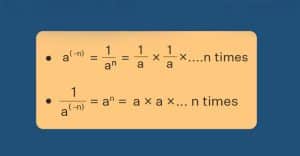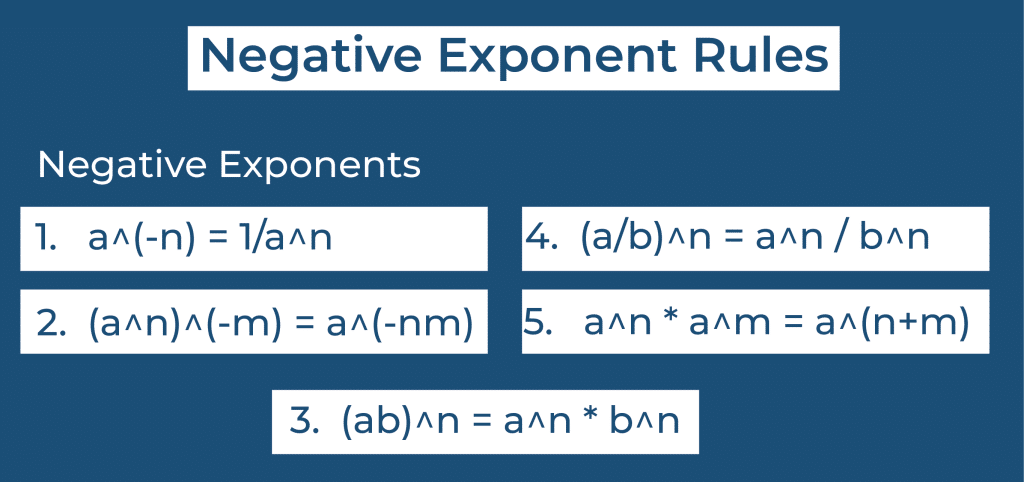Negative Exponents
Grade 6 Math Worksheets
Negative exponents are exponents that have a negative value. They indicate that the base of a number should be inverted or taken to the reciprocal.
For example, the expression x^(-2) is the same as 1/x^2 or the reciprocal of x squared. Negative exponents can represent very small or very large numbers, typically by multiplying a coefficient by 10 raised to a negative power.
In this article, we will cover:
- Negative Exponents Rules
- What is the Difference Between Negative Exponents and Positive Exponents?
"We really love eTutorWorld!"
"We really love etutorworld!. Anand S and Pooja are excellent math teachers and are quick to respond with requests to tutor on any math topic!" - Kieran Y (via TrustSpot.io)
"My daughter gets distracted easily"
"My daughter gets distracted very easily and Ms. Medini and other teachers were patient with her and redirected her back to the courses.
With the help of Etutorworld, my daughter has been now selected in the Gifted and Talented Program for the school district"
- Nivea Sharma (via TrustSpot.io)
Negative exponents also use in more abstract mathematical contexts, like complex numbers and polynomials. Also, it can be used for solving equations that involve physical units and other advanced mathematical concepts.

It’s important to understand the properties and rules for working with negative exponents to evaluate and simplify expressions that involve them properly.
Negative Exponents Rules
There are a few rules for exponents that are only for negative exponents. Here are some rules working with negative exponents that you should be familiar with:
1. a^(-n) = 1/a^n
This rule states that when you have a negative exponent, you can simplify the expression to get the solution by taking the reciprocal of the base raised to the positive exponent.
2. (a^n)^(-m) = a^(-nm)
This rule states that when you have a term raised to a power, and the power itself is raised to another power, you can simplify the expression by dividing the exponent by the power.
3. (ab)^n = a^n * b^n
This rule states that when you have a product of two or more bases raised to a power, you can simplify the expression by raising each base to the power individually.

4. (a/b)^n = a^n / b^n
This rule states that when you have a quotient of two bases raised to a power, you can simplify the expression by raising each base to the power individually.
5. a^n * a^m = a^(n+m)
This rule states that when you have the product of two or more powers of the same base, you can simplify the expression by adding the exponents.
It’s important to remember these rules and practice applying them so that you can easily simplify and evaluate expressions that involve negative exponents. Also, practicing these rules by attempting worksheets or sample questions can help you cement your understanding of the concept well, whether it is the multiplication of negative exponent or any other application.
“There have been times when we booked them last minute, but the teachers have been extremely well-prepared and the help desk at etutorworld is very prompt.
Our kid is doing much better with a higher score.”
6th Grade Tutoring
eTutorWorld offers Personalized Online Tutoring for Math, Science, English, and Standardised Tests.
Our Tutoring Packs start at just under $22.49 per hour, and come with a moneyback guarantee.
Schedule a FREE Trial Session, and experience quality tutoring for yourself. (No credit card required.)
What is the difference between negative and positive exponents?
The main difference between negative and positive exponents is how they affect a number’s base.
A positive exponent indicates that a number is multiplied by itself several times. Let’s see an example step by step, 2^3 = 2*2*2 = 8, which means 2 is multiplied by itself 3 times.
On the other hand, a negative exponent indicates that the reciprocal of a number is being multiplied by itself a certain number of times. The reciprocal of a number is the number flipped upside down, 1/number. For example, 2^(-3) = 2*2*2 = 1/8, which means the reciprocal of 2 is multiplied by itself 3 times.
Do You Stack Up Against the Best?
If you have 30 minutes, try our free diagnostics test and assess your skills.
Another way to understand negative exponents is that it’s the same as taking the reciprocal of the number with the positive exponent. So, for example 2^3 = 8 and 2^(-3) = 1/8. They both are reciprocal to each other.
So, in simple terms, positive exponents are used to represent a number being multiplied by itself, while negative exponents are used to representing the reciprocal of that same number being multiplied by itself.

Gloria Mathew writes on math topics for K-12. A trained writer and communicator, she makes math accessible and understandable to students at all levels. Her ability to explain complex math concepts with easy to understand examples helps students master math. LinkedIn
Affordable Tutoring Now Starts at Just $22.49
eTutorWorld offers affordable one-on-one live tutoring over the web for Grades K-12. We are also a leading provider of Test Prep help for Standardized Tests (SCAT, CogAT, MAP, SSAT, SAT, ACT, ISEE, and AP).
What makes eTutorWorld stand apart are: flexibility in lesson scheduling, quality of hand-picked tutors, assignment of tutors based on academic counseling and diagnostic tests of each student, and our 100% money-back guarantee.
Whether you have never tried personalized online tutoring before or are looking for better tutors and flexibility at an affordable price point, schedule a FREE TRIAL Session with us today.
*There is no purchase obligation or credit card requirement
Grade 6 Science Worksheets
- Inquiry process
- Nature of Science
- Scientific Inquiry
- Inquiry, Analysis and Problem Solving
- Ethical Practices
- Science and Society
- Biotic and Abiotic Factors
- Impact of Organisms
- Adaptation
- Spheres of Earth
- Natural Resources
- Environmental Issues
- Conservation of Earth
- Understanding Technology
- Abilities To Do Technological Design
- Structure of Earth
- Solar System
- Rocks and Fossils
- Earth Systems
- Plate Tectonics
- Evolution
- Magnetic Field of Earth
- Geologic Time
- Materials and Processes That Shape a Planet
- Astronomy
- Ecology
- Energy
- Kinetic and Potential Energy
- Energy Transfer
- Matter and its Structure
- States of Matter
- Physical and Chemical Changes
- Force and Motion
- Electricity and Magnetism
- Wave Interactions
- Sound
- Light
- Introduction to Life Science
- The Origin & History of Life On Earth
- Plant and Animal Cells
- Parts of a Cell
- The Cell Cycle
- How Living Organisms Get Energy
- Classification of Organisms
- How Plants Grow & Reproduce
- The Human Respiratory System
- The Human Cardiovascular System
- The Human Digestive System
- The Human Endocrine Systems
- The Human Nervous System
- The Human Muscular System
- The Human Skeletal System
IN THE NEWS

Our mission is to provide high quality online tutoring services, using state of the art Internet technology, to school students worldwide.
Online test prep and practice
SCAT
SSAT
ISEE
PSAT
SAT
ACT
AP Exam
Science Tutoring
Physics Tutoring
Chemistry Tutoring
Biology Tutoring
Math Tutoring
Pre-Algebra Tutoring
Algebra Tutoring
Pre Calculus Tutoring
Calculus Tutoring
Geometry Tutoring
Trigonometry Tutoring
Statistics Tutoring
Quick links
Free Worksheets
Fact sheet
Sales Partner Opportunities
Parents
Passive Fundraising
Virtual Fundraising
Our Expert Tutors
Safe and Secure Tutoring
Interactive Online Tutoring
After School Tutoring
Elementary School Tutoring
Middle School Tutoring
High School Tutoring
Home Work Help
Math Tutors New York City
Press
©2022 eTutorWorld Terms of use Privacy Policy Site by Little Red Bird
©2022 eTutorWorld
Terms of use
Privacy Policy
Site by Little Red Bird










